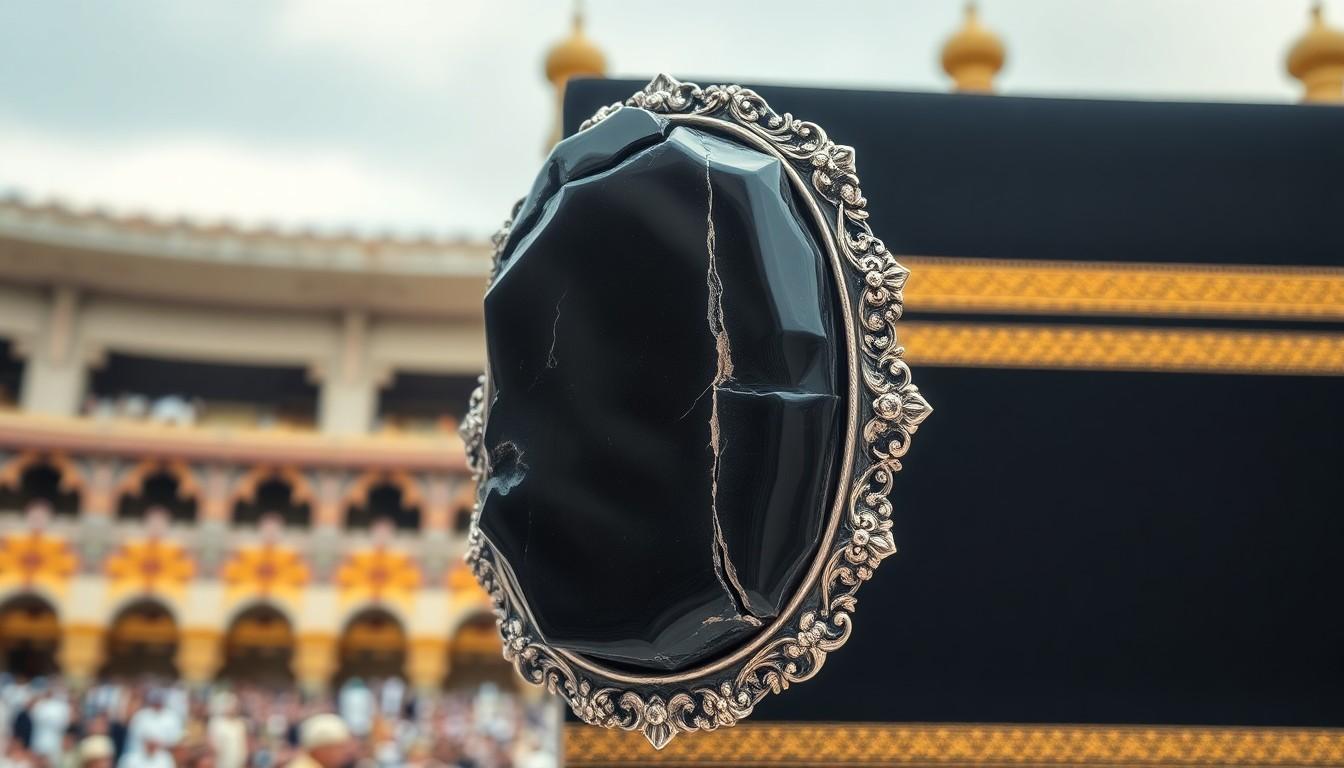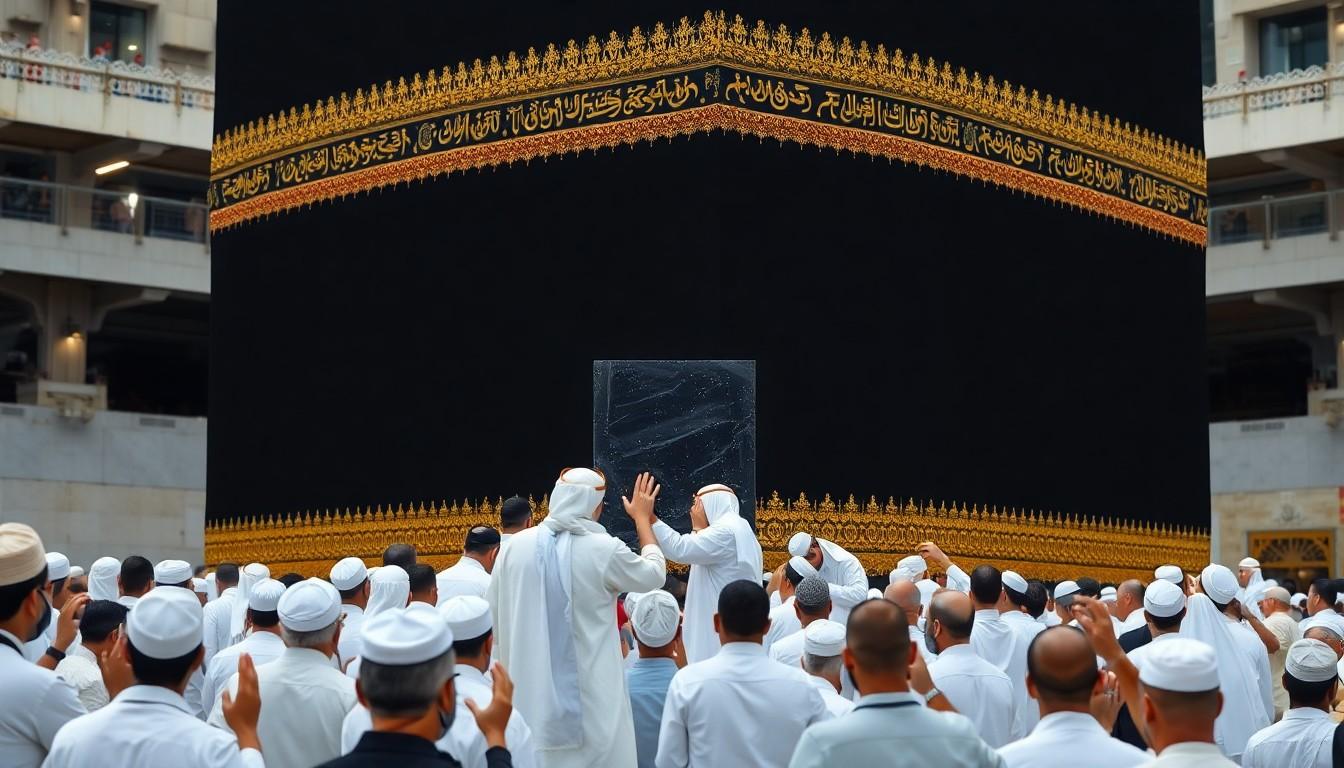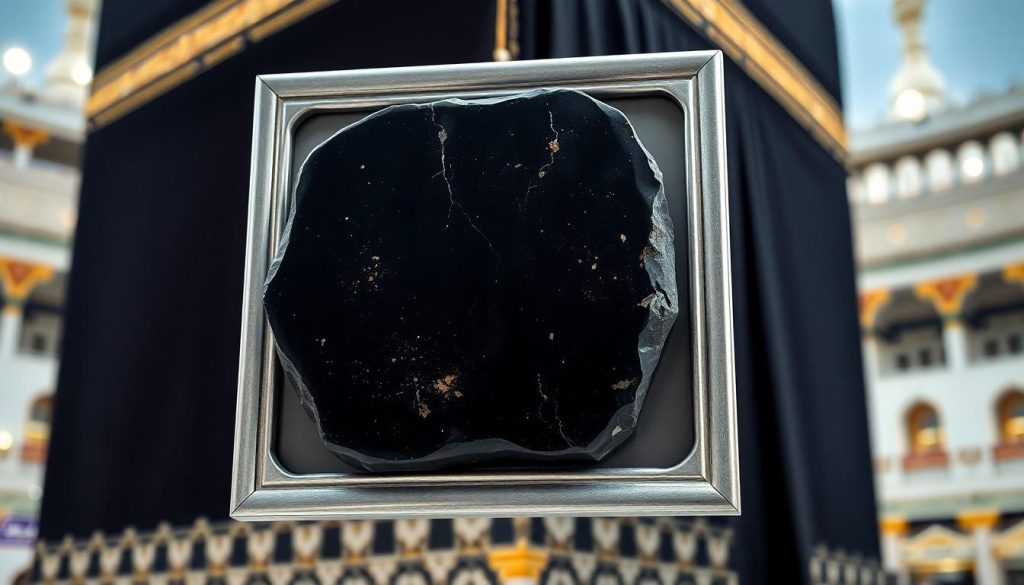The Black Stone (Hajar al-Aswad) inside the Kaaba is one of Islam’s most revered relics. Located in the eastern corner of the sacred cube-shaped structure in Mecca, Saudi Arabia, this celestial stone has captivated millions of faithful pilgrims for over 1400 years.
According to Islamic tradition, the stone descended from heaven during Adam’s time, appearing pure white before gradually darkening due to humanity’s sins. Today, it’s embedded in the Kaaba’s exterior wall, where millions of Muslims attempt to kiss or touch it during their Hajj pilgrimage. While its exact origins remain debated by historians, the stone’s significance in Islamic worship and its role in marking the starting point of Tawaf (circumambulation) makes it an integral part of the Muslim faith and practice.
What Is the Black Stone Inside the Kaaba
The Black Stone (Hajar al-Aswad) resides in the eastern corner of the Kaaba at the Grand Mosque in Mecca, Saudi Arabia. Located in an area known as al-Rukn al-Aswad (the Corner of the Black Stone), this sacred relic consists of multiple fragments held together by a silver frame.
Physical Characteristics
- Fragments: Multiple pieces cemented together
- Frame: Silver band encasing the fragments
- Mounting: Secured to the Kaaba’s exterior wall
- Setting: Surrounded by a ring of stone
Religious Origin
According to Islamic tradition, the Black Stone’s origins trace back to Adam and Eve’s time. The stone underwent a remarkable transformation:
- Initial State: Pure white in color
- Current State: Black coloration
- Cause of Change: Absorption of pilgrims’ sins through centuries of touching and kissing
The stone’s placement in the eastern corner of the Kaaba marks it as a focal point for Islamic rituals. Its integration into the silver frame preserves the fragments while allowing pilgrims to interact with this sacred object during religious observances.
| Feature | Description |
|---|---|
| Location | Eastern corner of Kaaba |
| Original Color | White |
| Current Color | Black |
| Construction | Multiple fragments |
| Preservation | Silver frame mounting |
| Cultural Status | Sacred Islamic relic |
Historical Origins of the Sacred Stone

The Black Stone, or Hajar al-Aswad, is significant in Islamic and pre-Islamic history. Its journey through time encompasses ancient traditions, divine origins, and historical events that shaped its current state.
Islamic Traditions About Its Divine Origins
Islamic tradition connects the Black Stone to the earliest days of human existence. According to these accounts, Prophet Ibrahim and his son Ismail placed the stone in the Kaaba’s wall during its construction in 605 CE, five years before Muhammad received his first revelation. The stone’s integration into the Kaaba marked a pivotal moment in Islamic history as Muhammad participated in its placement.
Pre-Islamic Significance
The Black Stone held a revered status even before the advent of Islam. Ancient Arabian communities incorporated the stone into their pagan rituals at the Kaaba, where it resided alongside statues of various deities. The stone underwent significant physical changes throughout its history, most notably during the 683 CE Umayyad siege of Mecca when a catapult strike fractured it into multiple pieces. Abdullah bin Zubair later restored the stone’s integrity by creating a silver frame to hold the fragments together, a solution that still preserves the stone’s structure.
Physical Description and Appearance

The Black Stone (Hajar al-Aswad) measures approximately 30 centimeters in diameter and rests 1.5 meters above ground level in the eastern corner of the Kaaba. Its distinctive appearance reflects centuries of religious significance and historical events that have shaped its current form.
Current Condition and Housing
The Black Stone consists of multiple fragments held together by a heavy silver band embedded in the Kaaba’s eastern wall. The silver frame encases the fragments within a ring of stone, protecting the sacred relic while making it accessible to pilgrims. Originally pure white, the stone has transformed into black over time, with Islamic tradition attributing this change to the absorption of pilgrims’ sins through countless acts of devotion.
Religious Significance in Islam

The Black Stone (al-Ḥajar al-Aswad) represents a cornerstone of Islamic faith with deep spiritual meaning. According to Islamic tradition, this sacred stone descended from heaven during Adam’s time, marking its divine origin and significance in Muslim worship.
Role in Hajj Rituals
The Black Stone plays a central role in the Hajj pilgrimage rituals at the Kaaba. Pilgrims begin their Tawaf (circumambulation) from the eastern corner where the stone resides, marking each circuit by facing or gesturing toward it. Islamic tradition establishes three accepted ways to honor the stone during Tawaf:
- Kissing the stone directly
- Touching it with the hands
- Pointing toward it from a distance when crowds prevent close contact
- Functions as the starting point for daily prayers (qiblah)
- Symbolizes humanity’s covenant with Allah
- Represents divine forgiveness through its transformation from white to black
- Connects modern Muslims to the prophetic legacy of Abraham Ibrahim
- Serves as a physical link between paradise and earth
| Historical Aspect | Detail |
|---|---|
| Original Color | Pure White |
| Current Color | Black |
| Installation Date | 605 CE |
| Location | Eastern Corner of Kaaba |
| Height from Ground | 1.5 meters |
Preservation Efforts Through History
The Black Stone has endured extensive preservation measures throughout history to maintain its sacred status. Multiple interventions have protected its integrity while ensuring continued accessibility for pilgrims.
Notable Damage and Repairs
Significant preservation efforts began in 930 CE during a crucial reconstruction of the Kaaba. Prophet Muhammad resolved a dispute among clan elders by suggesting they collectively carry the stone on a cloth, placing it in its current position. This method established a precedent for future handling of the sacred relic.
Modern Protection Measures
The Black Stone receives comprehensive protection through:
- Silver Frame: A heavy-duty silver encasement secures the stone’s fragments
- Security Personnel: Dedicated guards monitor the stone 24/7
- Climate Control: Environmental systems regulate temperature exposure
- Access Management: Organized queuing systems control pilgrim flow
- Documentation: Regular photographic records track the stone’s condition
- Physical Barriers: Protective structures prevent direct contact damage
These measures balance preservation needs with religious accessibility, maintaining the stone’s integrity for future generations while allowing pilgrims to perform traditional rituals.
Conclusion
The Black Stone stands as a remarkable testament to the Islamic faith and history spanning over 1400 years. Its journey from heaven to earth and transformation from pure white to black symbolizes humanity’s spiritual path. This sacred relic continues to draw millions of pilgrims who seek its blessings during their Hajj pilgrimage.
Extensive preservation efforts throughout history highlight the stone’s immense significance to the Muslim world. Despite physical changes and historical challenges, the Black Stone remains a powerful symbol of divine connection and spiritual renewal. Its presence in the Kaaba is a constant reminder of mankind’s covenant with Allah and the enduring legacy of Prophet Ibrahim.

